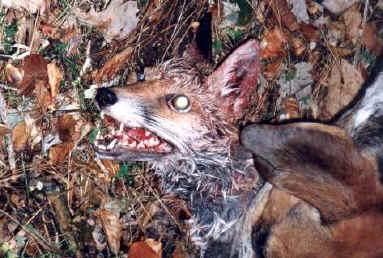Fox hunting
henk - 16.10.2002 00:43
fox hunting; short history

 http://www.grahamhancock.com/phorum/read.php?f=2&i=34928&t=34928 http://www.grahamhancock.com/phorum/read.php?f=2&i=34928&t=34928
Foxhunting has only existed for the last 250 years and was developed as entertainment for the aristocracy and landed gentry. Previously foxes were much persecuted as ‘vermin’ but not considered worthy of the ‘chase’ which hitherto had been restricted to deer, hares, boar and wolves. As the wolf and boar became extinct, and the forests and the deer herds declined, hunters sought a new quarry. It was found that by blocking up fox earths and badger setts, thus denying foxes a natural escape, a fox could run fast and far enough to provide a good chase for dogs and riders before it succumbed to exhaustion. It also became necessary for hunts to carry small terriers to evict any fox which managed to find an unblocked hole. If a fox refused to ‘bolt’ from its refuge it would remain under attack by the terriers until it could be dug out. The use of terriers to attack foxes underground has now evolved as a ‘sport’ in its own right defended and promoted by the Countryside Alliance (formerly the British Field Sports Society).
What Happens at a Hunt
The official foxhunting season begins on 1st November and continues through to April. Some hunts even go on into May. Fox cubs are usually born in March which means that pregnant and nursing vixens are hunted and killed by dogs. Incidents of vixens being killed, and unborn cubs being scattered around by the dogs at a kill, have been recorded on film.
There are around 200 fox hunts in Britain which hunt an average of two to three days per week. In addition there are some ‘harrier packs’ and some unofficial packs (mainly in Wales) which also hunt foxes.
The night before the hunt ‘meet’, a hunt servant known as an ‘earthstopper’ searches the area to be hunted for fox earths, drains and badger setts down which a hunted fox may attempt to escape. The fox-earths and drains are blocked up with a variety of materials including oil drums, sacks of rubble, logs, rock and hard-packed earth. Legally, badger setts can only be lightly blocked.
After moving off from the meet, the dogs are sent into a ‘covert’ to seek out a fox. A fox could be found almost immediately and flushed out, or alternatively there could be a long delay. When the fox sprints away, the huntsman calls the pack together to follow the scent trail left by the fox. A hunted fox will naturally run to the nearest earths and other holes familiar to it, but they are likely to be blocked. It is then forced to run as far and as fast as it can; as the fox is a predator and has not evolved for long sustained chases, it cannot compete with the superior stamina of the slower-running but persistent dogs.
The Kill
Eventually it becomes exhausted whereupon the dogs catch up, swarm over the fox and savage it to death. If a fox manages to find refuge in an open hole (termed ‘unsporting’ by hunters!) the huntsman calls for the ‘terriermen’ to enter their dogs into the hole in an attempt to either drive it out for further hunting or keep it under attack until it is dug out. The ‘bolting’ of foxes for further hunting was condemned as cruel by a Government enquiry in 1951 which recommended that the practice be abolished (Ref: The Report of the Committee on Cruelty to Wild Animals, otherwise known as the Scott Henderson Report, named after the Chairman).
Hunting enthusiasts claim that the first dog to reach the fox gives it a ‘nip to the back of the neck’ which kills it instantly. This claim ignores the cruelty brought about by the deliberately prolonged chase. However, it is known that the ‘neck-bite’ is a method of killing more commonly used by large wild cats - some species of which hunt alone and require their prey to be immobilised by the breaking of the vertebrae. Canids (wolves, jackals, dogs etc,) that hunt in packs, tend to bring down their prey by a series of bites and tears to the quarry’s sides and hind-quarters. In the wild, packs are formed for hunting in order that a larger prey animal may be caught and provide food for the pack. There is no pack-predator in the natural world which would expend considerable energy chasing an animal which, even if caught, would only provide a tiny mouthful for each member of the pack.
It is well-known in hunting circles that foxes fighting for their lives with the pack of dogs, often manage to inflict a bite or two. These wounds are described in hunting literature as ‘wounds of honour’ and prove that foxes are not killed instantaneously by the first dog to make contact. There are also several recorded instances of the hounds attacking small pet dogs and cats which, although fatally savaged, survived the initial attack - further evidence that the dogs do not kill their prey instantly.
When the fox is dead the practice of most hunts is to cut off the tail (‘brush’), the feet (‘pads’) and the head (‘mask’) as trophies. The carcass is thrown to the dogs. Some hunts still indulge in the practice of ‘blooding’ - the smearing of fresh fox-blood on the faces of those, usually children, who have witnessed their first kill.
|


